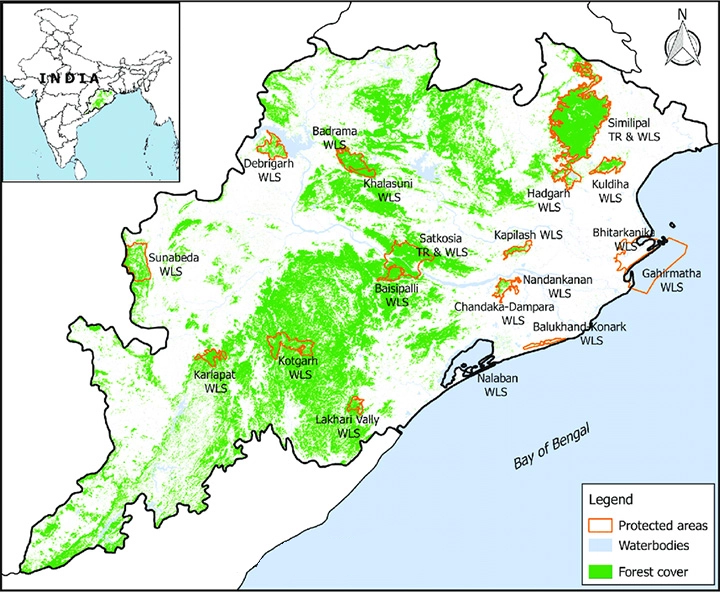Important Facts For Prelims
Bhitarkanika National Park
- 25 Aug 2022
- 5 min read
Why in News?
Recently, the Bhitarkanika National Park have reached a saturation point in the population of crocodile which could lead to more human-Crocodile conflict.
What is Bhitarkanika National Park?
- About:
- Bhitarkanika National Park is spread in a vast area of 672 Kms in Orissa.
- It is the second largest Mangrove ecosystems of India.
- The National Park is essentially a network of creeks and canals which are inundated with waters from rivers Brahmani, Baitarani, Dhamra and Patasala forming a unique ecosystem.
- Its proximity to Bay of Bengal makes the soil of the area enriched with salts, the vegetation and the species of the sanctuary is comprised of those which are mainly found in the tropical and subtropical inter tidal regions.
- It is the breeding place for the Salt Water Crocodiles.
- The Gahirmatha Beach which forms the boundary of the sanctuary in the east is the largest colony of the Olive Ridley Sea Turtles.
- The other unique phenomenon is the Bagagahana or the heronry near Surajpore creek.
- Thousands of birds colonise the creek for nesting and the aerial acrobatics performed prior to mating make for an impressive sight.
- Bhitarkanika is also home to eight varieties of Kingfisher birds which is also a rarity.
What are the Issues?
- Rising conflict:
- Almost, 50 people have been killed by crocodiles since 2012 in and around the park, while 25 crocodiles died during the same time after entering human settlements or getting caught in fishing nets.
- Territorial Reptile:
- Crocodile is a territorial aquatic reptile, that means too many crocodiles can’t live in a small area as there will be increased competition for food, mating partners, basking sites.
- Historical perspective:
- The Union Ministry of Forest and Environment in 1991 had directed the state forest department to stop the crocodile rearing programme in Bhitarkanika due to the saturation point reached by crocodile population.
- However, the government stopped funding for the crocodile breeding and rearing project in 1990.
- Further, the forest department had stopped the crocodile breeding and release programme in 1995 in the park as the crocodile population had reached around 1,000, from 94 in 1975.
- The Union Ministry of Forest and Environment in 1991 had directed the state forest department to stop the crocodile rearing programme in Bhitarkanika due to the saturation point reached by crocodile population.
What is Crocodile Conservation Project?
- The crocodile conservation project in Bhitarkanika was started in 1975.
- Its main objective was to protect the reptiles’ natural habitats and to rebuild the population quickly through captive breeding as the survival rate of crocodile hatchlings in nature is low because of predation.
- Since Odisha is recognized for the existence of all the three species of Indian crocodilians, the Gharial and Saltwater crocodile conservation programme was first implemented in Odisha in early 1975 and subsequently, the Mugger conservation programme was initiated.
- The UNDP/ FAO provided funds and other technical support through the Government of India.
Way Forward
There is a need to take steps for the reduction in the crocodile population and also the Government needs to take measures for the redistribution of crocodiles into wetlands of entire mangrove forests of Bhitarakanika and Mahanadi River system.
UPSC Civil Services Examination Previous Year Question:
Prelims
Q. if you want to see gharials in their natural habitat, which one of the following is the best place to visit? (2017)
(a) Bhitarkanika Mangroves
(b) Chambal River
(c) Pulicat Lake
(d) Deepor Beel
Ans: (b)
Exp:
- National Chambal Sanctuary, also called the National Chambal Gharial Wildlife Sanctuary, is a 5,400 sq km tri-state, namely MP, Rajasthan and UP protected area in northern India for the protection of the critically endangered gharial, the red-crowned roof turtle and the endangered Ganges river dolphin.
- The gharial (Gavialis gangeticus), also known as the gavial, and fish-eating crocodile is a crocodilian in the family Gavialidae, and is native to the northern part of the Indian subcontinent.
- The global wild gharial population is estimated at fewer than 235 individuals, which are threatened by loss of riverine habitat, depletion of fish resources, and entanglement in fishing nets. As the population has declined drastically since the 1930s, the gharial is listed as critically endangered on the IUCN Red List. Therefore, option (b) is the correct answer







